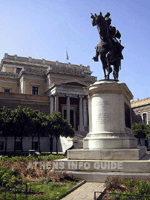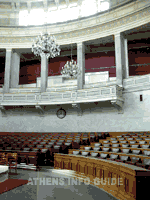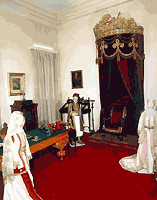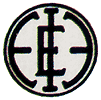
National
Historical Museum
The
National Historical Museum is located in the beginning of Stadiou
Street, a short distance from Syntagma Square. It was built on
the site of the former residence of Al. Kontostavlos, one of the
richest merchants of Athens and, even earlier in 1813, it was
the residence of King Otto of Greece. After the constitutional
movement of 3 September 1843 and the grant of a constitution by
King Otto in 1844, the building became the seat of the Greek Parliament.
It was used for meetings of the Parliament and the Senate.
 In
October 1854 the building was completely destroyed by fire. A
new, neoclassical building was built in 1858 designed by the architect
François Boulanger. Designed primarily as a parliament
building, it included two amphitheatres, one for parliamentary
meetings and another for meetings of the Senate. Construction
stopped soon after it started because of financial difficulties.
By the time they resumed again in 1863, the institution of the
Senate had been abolished, which necessitated a change of plan
and the necessary modifications were made by the Greek architect
Panagiotis Kalkos. In
October 1854 the building was completely destroyed by fire. A
new, neoclassical building was built in 1858 designed by the architect
François Boulanger. Designed primarily as a parliament
building, it included two amphitheatres, one for parliamentary
meetings and another for meetings of the Senate. Construction
stopped soon after it started because of financial difficulties.
By the time they resumed again in 1863, the institution of the
Senate had been abolished, which necessitated a change of plan
and the necessary modifications were made by the Greek architect
Panagiotis Kalkos.
The
building founded in 1835 by Queen Amalia, was completed in 1871
and it housed the Parliament from 1875 to 1935 when the institution
was transferred to the Old Palace in Syntagma Square. The building
then served as the Ministry of Justice and from 1962 it houses
the National Historical Museum created by the Historical and Ethnological
Society of Greece. The old parliament is an architectural jewel
in the centre of Athens. While its grand congress hall is a place
of historic significance, it also is appropriate for hosting major
cultural and historical events today. A great segment of the collection,
gathered since the founding of the society, is part of the permanent
exhibition of the museum, presented in the rooms encircling the
congress hall.
The
collection of the National History Museum covers modern Greek
history and folklore from the 15th to the 20th century AD. Exhibits
from the periods of Frankish and Ottoman rule (15th to 19th century)
are displayed as well as the preparation, the outbreak and the
development of the War of Independence of 1821.
 There
are also exhibits connected with There
are also exhibits connected with
•
prominent Greek scholars and clergymen, the philhellenes,
Ioannis Kapodistrias, the first Governor of Greece (1828-1831)
• the reign of Otto, first king of Greece (1833-1862)
• the reign of King George I (1864-1913)
• the Balkan Wars (1912-1913)
• the Asia Minor Campaign (1919-1922)
• the Greek-Italian War of 1940-1941
The
historical exhibits consist of collections of historical and folklore
material including weaponry, flags, works of art, memorabilia,
medals, personal items of historical figures, furniture, folk
costumes and everyday life and folk art items.
The
area around the Old Parliament has three statues. On the square
leading from Stadiou Street you’ll find the statue of Theodoros
Kolokotronis on horseback. He was one of the leading figures of
the War of Independence, the battle of Dervenakia and the Assembly
of the Peloponnesian Senate.
On
the sides of the museum there are statues of two Greek politicians
of the 19th century, Charilaos Trikoupis (by Thomas Thomopoulos,
1920) and Theodoros Diligiannis, the Prime Minister who was assassinated
at the entrance to the Parliament in 1905 (Georgios Dimitriadis,
1924).
Today,
the National Historical Museum is also a research centre for modern
Greek history.
 The
Historical and Ethnological Society of Greece The
Historical and Ethnological Society of Greece
The
society was established in 1882 by prominent scholars
and artists. Among them were  Timoleon
Filimon (first president of the society), Nikolaos Plitis,
Spyridon Lambros, Dimitrios Kombouroglou, Antonios Miliarakis
and Georgios Drosinis. Timoleon
Filimon (first president of the society), Nikolaos Plitis,
Spyridon Lambros, Dimitrios Kombouroglou, Antonios Miliarakis
and Georgios Drosinis.
The
society’s aim is to preserve and promote the material
and spiritual monuments of modern Greek history. It established
the Historical Ethnological Museum in 1896, the forerunner
of the National Historical Museum which was housed in
a room of the Technical University of Athens. Today, apart
from the National Historical Museum, the society has a
historical archive and a library and it is active in research
and publishing.
|
 Opening hours and admission
Opening hours and admission
 13, Stadiou Street
13, Stadiou Street
 Syntagma
Syntagma 

|

